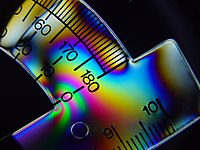
Photo from wikipedia
Abstract Swelling of SiC at 300 ∘ C due to in-service neutron irradiation causes tensile residual stresses in coatings which are expected to adversely affect the performance of coated SiC… Click to show full abstract
Abstract Swelling of SiC at 300 ∘ C due to in-service neutron irradiation causes tensile residual stresses in coatings which are expected to adversely affect the performance of coated SiC composite fuel cladding for light water reactors. Matching the coating swelling with the substrate, a solution common for thermal expansion, is not practical in the case of neutron irradiation. Biasing samples during magnetron sputtering deposition induces compressive residual stress which may counteract this. In this study, chromium coatings were deposited on SiC by DC magnetron sputtering with no external heating at bias voltages of –50V, –75V, and –100V. The effects of the bias voltage on morphology, residual stress, microstrain, texture, and adhesion are shown. The low deposition temperature resulted in the coating microstructure evolution following an energetic particle bombardment dominated trend. At the two lower bias voltages knock-on implantation dominated increasing the residual stress and microstrain while at the highest bias voltage, thermal spike migration allowed for defect relaxation. When the knock-on induced compressive residual stress exceeded 0.8 GPa microcrack formation in the SiC substrate decreased coating adhesion. While no microcracks formed at the lowest bias voltage, insufficient atomic mobility during coating growth lead to voids forming in the coating. A balance is needed to form void-free coatings that have high compressive residual stress.
Journal Title: Journal of Nuclear Materials
Year Published: 2021
Link to full text (if available)
Share on Social Media: Sign Up to like & get
recommendations!